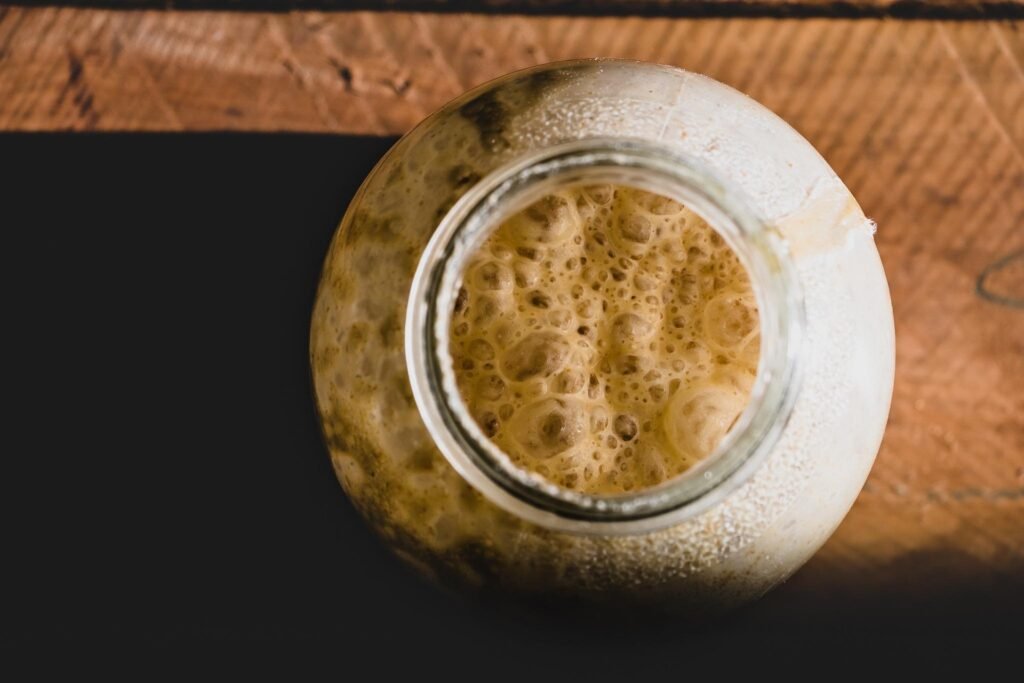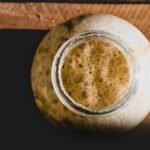Looking for a simple sourdough starter recipe? Here is a is a simple mix of flour and water that captures wild yeast and bacteria from your environment. With just a few minutes a day, you can build a living culture that will power all your sourdough breads.
This recipe walks you through the process step by step. No commercial yeast, no complicated ingredients — just flour, water, and time.
Jump to RecipeIngredients
- 120 g (1 cup) whole wheat flour or rye flour (for best results starting out)
- 120 g (½ cup) water, filtered or dechlorinated
- Additional unbleached all-purpose flour and water for feedings
Equipment
- A glass jar or clear container (at least 1 quart)
- A spoon or spatula
- A kitchen scale (recommended for accuracy)
- A breathable cover (cloth, paper towel, or loose lid)
Method – Simple Sourdough Starter Recipe
Day 1
- Mix 120 g flour and 120 g water in your jar.
- Stir well until no dry bits remain.
- Cover loosely and leave at room temperature (70–75°F / 21–24°C).
Day 2
- You may or may not see bubbles yet. Don’t worry!
- Discard about half the starter. Add 60 g flour + 60 g water. Stir and cover again.
Days 3–5
- Feed every 24 hours: discard half, add fresh flour and water in equal weights.
- By Day 3 or 4, you should start seeing bubbles, a tangy smell, and some rise.
Days 5–7
- Continue daily feedings. Your starter should be doubling in size within 4–8 hours after feeding.
- Once it does this consistently for 2–3 days in a row, it’s ready to bake with.
Tips for Success for this Simple Sourdough Starter Recipe
- Flour choice matters: Whole wheat or rye helps kickstart fermentation. Once active, you can switch to all-purpose flour.
- Water quality counts: Chlorine can slow fermentation — if possible, use filtered or let tap water sit out overnight.
- Temperature is key: Starters thrive at 70–75°F (21–24°C). Cooler kitchens may take longer.
- Consistency check: A healthy starter smells pleasantly tangy, not rotten.
How to Maintain Your Starter
Once active, keep your starter alive with regular feedings:
- Frequent baker: Feed daily at room temp.
- Occasional baker: Store in the fridge and feed once per week. Bring to room temp and feed before baking.
Frequently Asked Questions About Sourdough Starters
1. How long does it take to make a sourdough starter?
Most starters are active and ready in 5–7 days, but sometimes it can take up to 10–14 days depending on temperature, flour type, and environment.
2. What should my starter smell like?
A healthy starter smells tangy, fruity, or slightly yeasty. If it smells like rotten eggs, mold, or anything unpleasantly foul, discard and restart.
3. Why isn’t my starter bubbling?
If you don’t see activity by Day 3 or 4, try:
- Switching to whole wheat or rye flour for feedings.
- Making sure your water isn’t heavily chlorinated.
- Moving your starter to a warmer spot (around 75°F / 24°C).
4. What if I see liquid on top (hooch)?
That’s a sign your starter is hungry. Simply stir it in or pour it off, then feed your starter.
5. Can I use my starter before it doubles?
No — it’s best to wait until it can double in size within 4–8 hours after feeding. This ensures it has the strength to raise bread dough.
6. What if I see mold?
If mold develops (fuzzy green, black, or pink spots), throw it out and start fresh. Mold cannot be salvaged safely.
7. Do I have to discard half every time?
Yes, in the beginning. Discarding keeps your starter at a manageable size and ensures the yeast has enough fresh food. Once established, you can scale feedings to your needs.
8. How do I know my starter is ready to bake?
- It doubles in size within 4–8 hours.
- It passes the “float test” (a spoonful of starter floats in water).
- It smells pleasantly tangy and yeasty.
9. Can I make a gluten-free starter?
Yes — use brown rice flour, sorghum, or buckwheat flour. It may need more frequent feedings and takes a bit longer to stabilize.
Final Thought
Making your own sourdough starter is a lesson in patience and simplicity. In under a week, you’ll have a living culture that connects you to centuries of bread-making tradition — and serves as the foundation for endless loaves to come.
Simple Sourdough Starter Recipe
Equipment
- A glass jar or clear container (at least 1 quart)
- A spoon or spatula
- A kitchen scale (recommended for accuracy)
- A breathable cover (cloth, paper towel, or loose lid)
Ingredients
- 120 g 1 cup whole wheat flour or rye flour (for best results starting out)
- 120 g ½ cup water, filtered or dechlorinated
- Additional unbleached all-purpose flour and water for feedings
Instructions
Day 1
- Mix 120 g flour and 120 g water in your jar.
- Stir well until no dry bits remain.
- Cover loosely and leave at room temperature (70–75°F / 21–24°C).
Day 2
- You may or may not see bubbles yet. Don’t worry!
- Discard about half the starter. Add 60 g flour + 60 g water. Stir and cover again.
Days 3–5
- Feed every 24 hours: discard half, add fresh flour and water in equal weights.
- By Day 3 or 4, you should start seeing bubbles, a tangy smell, and some rise.
Days 5–7
- Continue daily feedings. Your starter should be doubling in size within 4–8 hours after feeding.
- Once it does this consistently for 2–3 days in a row, it’s ready to bake with.

